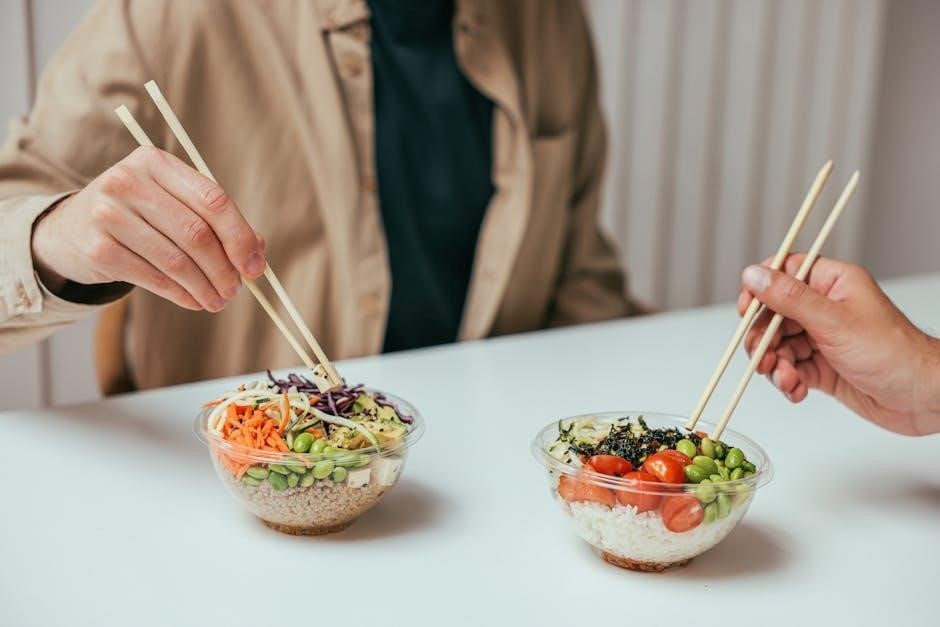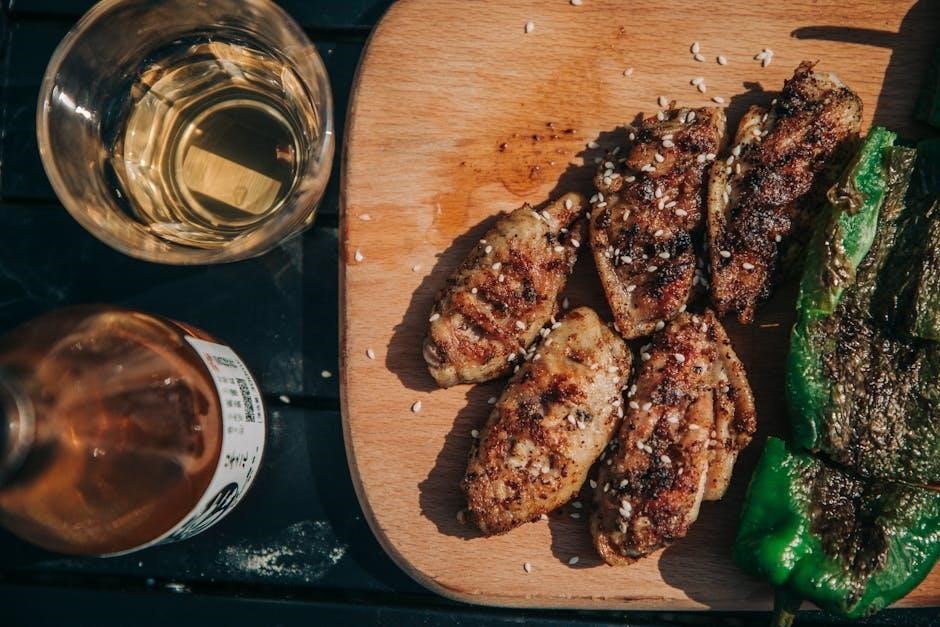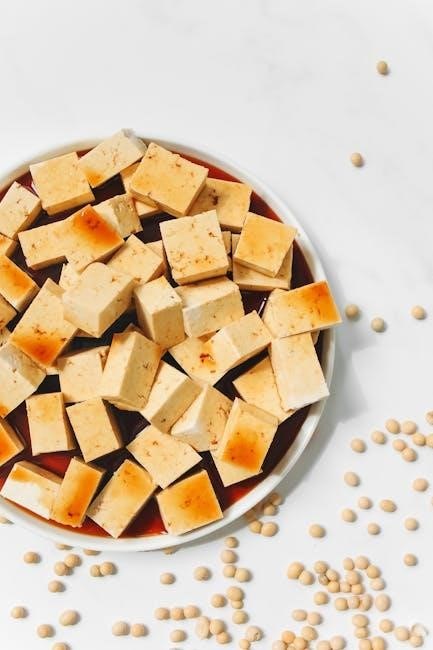A 1600-calorie high-protein meal plan is designed to support weight management and muscle growth while keeping you full. This structured plan balances protein, carbs, and fats, ensuring nutrient-dense meals tailored to your dietary needs.

Overview of the Meal Plan
This 1600-calorie high-protein meal plan is strategically designed to balance macronutrients while prioritizing protein-rich foods. It suits individuals aiming for weight management or muscle maintenance, offering a structured approach to daily nutrition. The plan allocates calories across breakfast, lunch, dinner, and snacks, ensuring variety and satiety. With a focus on whole foods, lean proteins, and healthy fats, it provides sustained energy and supports metabolic health. Adjustable based on activity levels, this plan is ideal for those seeking a balanced and sustainable dietary approach. It emphasizes nutrient-dense meals while keeping calorie intake in check, making it versatile for different fitness goals.
Benefits of a High Protein Diet
A high-protein diet supports muscle maintenance, increases satiety, and enhances metabolism, making it ideal for weight management and overall health while keeping you full and energized.
Muscle Maintenance and Growth
A high-protein diet is essential for muscle maintenance and growth, as protein provides the amino acids needed to repair and build muscle tissue. With a 1600-calorie meal plan, you can ensure adequate protein intake to support muscle health without consuming excess calories. This balance is particularly beneficial for those aiming to maintain or gain lean muscle mass while managing weight. Protein efficiency is key, and focusing on high-quality sources like lean meats, fish, and plant-based options maximizes muscle benefits; This approach ensures your body has the necessary nutrients to sustain and grow muscle effectively, even within a calorie-restricted framework.

Increased Satiety and Weight Management
A high-protein diet within a 1600-calorie plan enhances satiety, helping you feel fuller longer and reducing cravings. Protein requires more energy to digest, boosting metabolism and calorie burn. This makes it easier to stick to your weight management goals. By prioritizing protein-rich foods like lean meats, eggs, and legumes, you can control hunger and avoid overeating. The structured calorie intake ensures a balance that supports weight loss while maintaining muscle mass, making it an effective strategy for sustainable weight management and overall health improvement.
Improved Metabolism
A high-protein diet within a 1600-calorie plan can enhance metabolism by increasing thermogenesis, the body’s process of burning calories to digest food. Protein requires more energy to metabolize compared to carbohydrates or fats, which boosts your resting metabolic rate. This means your body burns more calories at rest, aiding in weight loss and fat reduction. Additionally, maintaining muscle mass through adequate protein intake further supports metabolic health, as muscle tissue burns calories more efficiently than fat. This combination of calorie control and protein-rich meals creates an optimal environment for improving metabolism and achieving long-term weight management goals.

Understanding Macronutrient Balance
Macronutrient balance involves distributing calories from protein, carbohydrates, and fats to meet dietary goals. A 1600-calorie high-protein plan emphasizes protein while balancing carbs and fats for optimal nutrition.
Role of Protein in a 1600 Calorie Diet
Protein plays a crucial role in a 1600-calorie diet, aiding muscle maintenance and satiety. With about 38.75% of calories from protein, it supports weight management and muscle repair efficiently.
Importance of Carbohydrates and Fats
Carbohydrates and fats are essential in a 1600-calorie meal plan, providing energy and supporting overall health. Carbs fuel physical activity, while fats aid in hormone production and nutrient absorption. Balancing these macronutrients ensures sustained energy levels and prevents nutrient deficiencies, complementing the high-protein focus for a well-rounded diet.

Calculating Protein Percentage in the Diet
To determine the protein percentage in a 1600-calorie meal plan, multiply the protein grams by 4 (since protein provides 4 calories per gram), then divide by the total calories. For example, if your diet includes 120g of protein, the calculation would be (120 * 4) / 1600 = 30%. This ensures a high-protein focus, typically ranging between 25-35% of total calories. This balance supports muscle maintenance, satiety, and weight management, aligning with the goals of a high-protein diet. Adjusting protein intake based on individual needs and activity levels helps optimize results.
Sample 7-Day Meal Plan
This structured meal plan provides balanced high-protein options for each day, ensuring variety and nutrient-dense meals. Designed by registered dietitians, it offers flexibility and delicious recipes.

Breakfast Options
Start your day with protein-packed breakfasts to fuel your metabolism. Options include Greek yogurt with berries and granola, egg whites with spinach, or a protein smoothie with almond milk. Keep portions controlled to stay within your 1600-calorie goal. Incorporate whole grains like oatmeal or whole-grain toast for added fiber. Avocado slices or a sprinkle of chia seeds can boost healthy fats. Ensure each meal balances protein, carbs, and fats to maintain energy levels. Variety is key to keeping breakfasts exciting and satisfying, helping you stick to your high-protein, low-calorie plan effortlessly.
Lunch Ideas
For a satisfying midday meal, opt for high-protein lunches that keep you energized. Grilled chicken breast with quinoa and steamed vegetables is a balanced choice. Turkey lettuce wraps with avocado and tomato offer a low-carb, protein-rich option. Tuna salad with mixed greens and a light vinaigrette is another great alternative. Include a side of roasted sweet potatoes or a small portion of brown rice for sustained energy. A protein-packed salad with eggs, chickpeas, and spinach can also be a nutritious option. Ensure portions are controlled to stay within your 1600-calorie goal while meeting your protein needs.
Dinner Recipes
End your day with protein-rich dinners that are both flavorful and nutritious. Grilled salmon with asparagus and a side of brown rice is a well-rounded option. Baked chicken breast with roasted Brussels sprouts and sweet potatoes provides sustained energy. For a low-carb option, try turkey meatballs with zucchini noodles and marinara sauce. A stir-fry with lean beef, broccoli, and cauliflower rice is another high-protein choice. Ensure portions are balanced to stay within your calorie goal. Each meal should include a variety of vegetables and a protein source to keep you satisfied and support your dietary objectives.

Snack Suggestions
Keep your energy levels steady with protein-rich snacks that are low in calories. Greek yogurt with fresh berries is a satisfying choice, offering around 15 grams of protein. Hard-boiled eggs or a handful of almonds provide a quick protein boost. A small serving of cottage cheese with sliced cucumber is another excellent option. For convenience, consider protein bars (look for low-sugar options) or a protein smoothie made with whey protein, spinach, and almond milk. These snacks are designed to keep you full without exceeding your daily calorie limit, supporting your high-protein diet goals effectively.

Creating a Customizable PDF Guide

Design a PDF guide with structured meal plans, nutritional breakdowns, and grocery lists. Include tips for meal prepping and customizing portions to suit individual preferences and goals.
Structuring the Guide for Easy Reference
Organize the PDF guide with clear sections, including daily meal plans, nutritional information, and grocery lists. Use tabs or bookmarks for easy navigation. Each day’s meals should be broken down into breakfast, lunch, dinner, and snacks, with corresponding macronutrient details. Include a table of contents at the beginning for quick access. Use bullet points and bold headings to highlight key information, making it easy to scan. Ensure the layout is clean and visually appealing, with sufficient white space to avoid clutter. This structure helps users quickly find the information they need, making the guide practical and user-friendly.
Including Nutritional Information
Each meal in the 1600-calorie high-protein PDF guide should include detailed nutritional information. List calories, protein, carbohydrates, and fats for each meal and snack. Specify the protein percentage, ensuring it aligns with high-protein goals. Include macronutrient ratios, such as 35-40% of calories from protein, to support muscle growth and satiety. Highlight fiber content and healthy fats to promote overall health. Use clear tables or charts for easy readability. Bold headings for each nutrient category can enhance visibility. This ensures users can track their intake accurately and make informed decisions to stay on track with their dietary goals.
Adding Grocery Lists and Meal Prepping Tips
A comprehensive grocery list is essential for the 1600-calorie high-protein meal plan. Organize items by category, such as proteins, vegetables, and healthy fats. Include staple pantry items like whole grains and spices. For meal prepping, suggest cooking proteins and grains in advance, portioning meals, and storing them in airtight containers. Provide tips on freezing meals for later use and reheating safely. Emphasize the importance of fresh ingredients and how to shop smartly to avoid waste. A sample shopping list and meal prep schedule can streamline the process, ensuring users stay organized and consistent with their dietary goals.

Tips for Sticking to the Meal Plan
Sticking to the 1600-calorie high-protein meal plan requires consistent planning, tracking intake, and commitment. Organize meals and snacks in advance to avoid deviations and maintain adherence.
Adjusting Calorie Intake Based on Activity Levels
Calorie needs vary based on activity levels. Sedentary individuals may find 1600 calories sufficient, while active people might require adjustments to maintain energy balance. Consulting a dietitian ensures personalized adjustments, optimizing weight management and muscle maintenance without over-restricting. Tracking daily activities helps tailor the meal plan effectively, ensuring it aligns with lifestyle demands while adhering to high-protein goals.
Incorporating Variety in Meals
Incorporating variety in meals ensures the diet remains engaging and nutritionally balanced. Rotate protein sources like lean meats, fish, legumes, and dairy to keep meals interesting. Include colorful vegetables and whole grains to add diversity and nutrients. Experiment with spices and cooking methods to avoid monotony. Meal prepping with different ingredients each day can also help maintain enthusiasm. Variety not only prevents boredom but also ensures a broad range of vitamins and minerals. This approach supports both physical health and mental well-being, making the 1600-calorie high-protein plan more sustainable and enjoyable in the long term.
Importance of Consistency
Consistency is key to achieving and maintaining weight management and muscle growth on a 1600-calorie high-protein diet. Sticking to the meal plan ensures steady nutrient intake and metabolism support. Regular eating patterns help maintain energy levels and prevent overeating. Over time, consistency builds healthy habits, making it easier to sustain long-term results. It’s important to track progress and adjust as needed, but staying committed daily yields the best outcomes. Consistency also helps the body adapt to the new calorie and protein intake, optimizing its efficiency in burning fat and preserving muscle mass. This regularity is crucial for overall success.